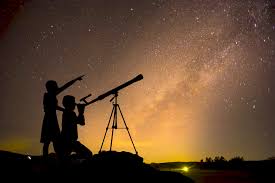Advertisements
Observing the sky is something that everyone has done at some point in their lives. Sometimes by chance, other times because they needed to think, cry or simply escape from reality for a while.
But the truth is that there is something about space that calls to us. It's hard to explain, but looking up usually brings a mix of peace, doubt and admiration.
Advertisements
You don't need to know anything about astronomy to be enchanted by the sky. All you need is a place with little light and a little free time.

Sometimes we don't even know what we're looking at, but the feeling of seeing infinity up there is enough to mess with our heads. There are nights when the sky seems more alive, and we feel that there is much more than just the routine down here.
Advertisements
Over time, I began to realize that the sky was also full of stories. Each planet has its own characteristics, each star has a lifespan, each galaxy is in motion.
We live in a rush here on Earth, while up there everything happens at a different pace, almost as if time were different. And maybe it really is.
Jupiter, for example, is a giant full of storms. Venus, although it is the planet of “love”, is too hot for any form of life. Mars, on the other hand, is the darling of research into life beyond Earth. And here we are, trying to survive our own chaos and dilemmas.
But the coolest thing is that you don't need to be a scientist to start exploring this universe. Nowadays, there are websites and apps that help anyone identify stars, planets and constellations just by pointing their cell phone at the sky. It's almost magic.

Do you want to observe the sky more easily?
If you want to start understanding better what you are seeing up there, it is worth visiting the website Stellarium Web.
It shows the sky in real time according to your location, and also allows you to identify stars, planets and constellations with ease. It is free and super intuitive. You can use it on both your cell phone and your computer.
Another good tip is the app Sky Map, which works like a portable star map. Just open the app, point your phone at the sky and voila: it shows you everything that's there, as if you had a space guide in your pocket. Ideal for those who want to get started without having to buy a telescope.
And the sky also changes with time
One curious thing is that the sky we see today is not the same as the one people saw thousands of years ago. The stars move, the constellations change position throughout the year and even the planets appear in different places depending on the time of year.
This shows how everything in the universe is always changing, just like us. Sometimes it seems like everything is still, but there is always something happening, even if we don't notice it with the naked eye.
Observing space is also a way of learning. You start out seeing only stars and, before you know it, you're already researching what a nebula is, how a star is born or why some planets have rings. It's a type of curiosity that grows slowly, at your own pace, and that helps you better understand the world and even your own existence.

Conclusion
Observing space is more than just looking at the sky; it’s a way to connect with something bigger, to ask questions and perhaps even find some answers. In a world full of noise and rush, stopping for a few minutes to observe the infinite can bring peace. Sometimes, all we need is to remember that there is so much more out there.




